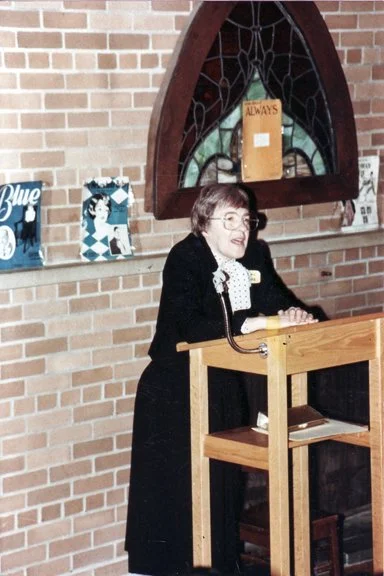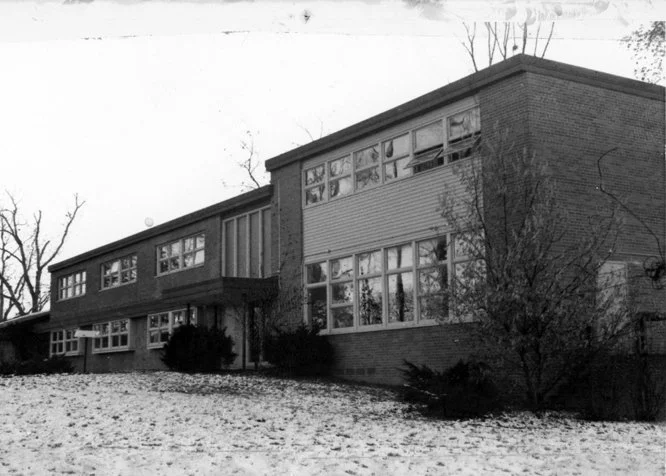A Year of Transformation: Highlights from the 1971–72 Annual Report
By Ed Busch, Church Archivist
This week I’m once again diving into one of the most valuable tools we have for understanding our church’s past: the annual report. These documents are a goldmine of institutional memory, and the 1971–72 report is no exception. It was a year of energy, expansion, and deep commitment from both lay and professional leaders.
This post also serves as a tribute to longtime member Marion Walsh, who passed away last month at the age of 99. Marion served as church president from 1970 to 1972—years marked by big change and bigger vision.
Marion Walsh, 1984 (2008.0671)
The Business of Being a Congregation
The Table of Contents from the 1971–72 report includes the standard but essential elements: meeting minutes, leadership reports, financial summaries, and committee updates.
As required by state law and church bylaws, the annual congregational meeting was held on April 16, 1972, and the agenda reflected the energy and responsibilities of a growing church. Items included receiving annual reports, nominating trustees, and adjusting the custodian’s salary—a practical but telling sign of growth.
But the most exciting announcement came a year earlier, on May 23, 1971, when Marion Walsh stood before the congregation and declared:
“We have a church!”
A motion by Paul Wright to officially ratify the board’s purchase of 855 Grove Street, East Lansing, passed unanimously. The move to a permanent home was the culmination of months of planning, meetings, and visioning.
UU Lansing Grove St. building, 1971. (2024.0134)
President’s Report: A Milestone Year
Marion Walsh captured the spirit of the year perfectly:
“This has been a good year for our church.”
She praised the collective effort that made the Grove Street acquisition possible and gave thanks to both the leadership team and the many behind-the-scenes volunteers. She expressed gratitude for Rev. Bob Green’s leadership in his second year, calling his sermons “always good, even when controversial,” and credited Alice Erickson for steering a vibrant Religious Education program.
Looking forward, Walsh emphasized two guiding goals:
“For the future, the key words are involvement and growth.”
She ended her report with hope that the church would continue to be a “strong and vital church that is a significant force in the community.”
Minister’s Report: “Not the Building, But What It Houses”
Rev. Robert Edward Green opened his report with a tone of heartfelt satisfaction:
“I am pleased. I do not say this just to make you feel good, but because that is how I feel.”
He reflected on the church’s new home as the year’s most visible milestone, but also reminded readers:
“Not the building but what it houses remains the significant matter. And what it houses are the people who make up this congregation.”
He honored the many volunteers who keep the congregation running, especially Marion Walsh and church secretary Betty Honey, who he said went “above and beyond the call of duty.”
An appendix to his report showed that Rev. Green was working an average of 67 hours per week (!), with additional unpaid administrative help from his wife, Carole Green. He performed 17 weddings, 4 memorial services, and reported a membership of 181, with 23 new members and 123 inactive names removed from the rolls per the Church Constitution.
Religious Education: A Fresh Start
Alice Erickson, Director of Religious Education, opened her report with joy:
“To have our own classrooms again has been a marvelous boost to the RE program.”
With space to decorate and settle in, RE teachers could finally offer consistent, engaging lessons. The program served about 80 children across 7 classes, using Beacon materials and other creative resources. The junior high class dove into “problem-centered” discussions, while all ages joined in for events like:
A fall hayride (chilly but spirited!)
A family game night with magic tricks
A lively “Children’s Sunday” service
A Christmas party, Earth Week trip, and churchyard clean-up day
Alice offered heartfelt thanks to committee members, volunteers, and high school helpers who made it all happen:
“Special thanks should be extended… to all the terrific adults and high school students who have helped to make the program… a satisfying and very exciting one!”
Adult Programming: Bold Ideas, Modest Crowds
Chairperson Pete Signell led a team that brought in thoughtful speakers and launched a Sunday morning discussion group. Topics ranged from school busing to the East Bengal crisis, pluralism in schools, and the American work ethic. They hosted a family Thanksgiving dinner and a Suitcase Theater performance.
Despite strong content, attendance was spotty:
“The number of participants present… seemed generally insufficient to justify continuance of the series.”
Still, the committee’s commitment to fostering dialogue and education deserves recognition.
Archivist’s Perspective: Not a Historian’s Story
A quick note on perspective: as an archivist, I approach these reports a little differently than a historian might. My focus is on preserving and showcasing the original voices and records of the time—letting the people who lived it speak for themselves. Historians often interpret or reframe the past with broader narratives, but archivists aim to curate and contextualize what was actually said and saved. That’s why you’ll see so many direct quotes and references here—they’re not just interesting, they’re the record.
Notes on Additional Reports in the 1971–72 Annual Report
This post highlights some of the more detailed and reflective sections of the 1971–72 Annual Report — particularly those from our minister, president, and religious education leaders. However, many other reports filled the pages of this important document and deserve acknowledgment for painting a fuller picture of church life during this transformational year.
The full report includes minutes from six special congregational meetings and the annual meeting; reflections from the Board of Directors; and detailed committee updates ranging from Finance, Membership, and Social Action to Coffee Hour, Denominational Affairs, and Music.
There are also financial reports that tracked the new building’s impact on our budget:
Pledge Drive Analysis
Financial Secretary and Treasurer Reports
Operating and Capital Fund Summaries
Each of these sections contributes in its own way to the larger story of a church finding its footing in a new home. While space doesn’t allow for detailed coverage of every report here, researchers and interested members can find the full 1971–72 document in our church archives. It’s worth the read.
Final Thoughts: A Foundation for the Future
Looking back at the 1971–72 church year, it’s clear that this was more than just a period of activity—it was a year of transformation. The purchase of a permanent home gave members a renewed sense of ownership and pride. From spirited sermons and snowy hayrides to community discussions and committee work, the congregation’s energy was contagious.
As Rev. Green wrote:
“Whatever is in our future we shall create, and I am confident that we shall create through our efforts a lasting and impressive mark.”
It’s a good reminder that behind every building, every budget line, and every committee report are the people who make a church what it is—then and now.
📬 Have questions or memories to share? I’d love to hear from you! I also like hearing that people are enjoying my posts. Contact the church archives at: uucgl.archives@gmail.com .
[With editing support from ChatGPT AI.]
Sources:
Annual Report, 1971-1972
———————————————————————————————————————————————-
About the Author
Hi, I’m Ed Busch, the writer behind these blog posts exploring the history of UU Lansing. After retiring in 2023 from a 15-year career as an Electronic Records Archivist at Michigan State University’s Archives & Historical Collections, I’m thrilled to dedicate my time to sharing our church’s rich history.
I hold a Master’s in Library and Information Science, specializing in archival administration, and my academic background also includes a degree in Fisheries and coursework in Computer Science. Before shifting to a career in archives, I worked across diverse fields, including fisheries, aerospace, and IT.
My wife, Leigh White, and I have been part of the UU Lansing community since the early 2000s and became members in 2006. I’ve been actively involved with the church archives since 2007, and both of our daughters enjoyed growing up in UU Lansing’s Religious Education (RE) program.
I look forward to connecting with you through these blog posts as we delve into the stories that have shaped UU Lansing over the years.


